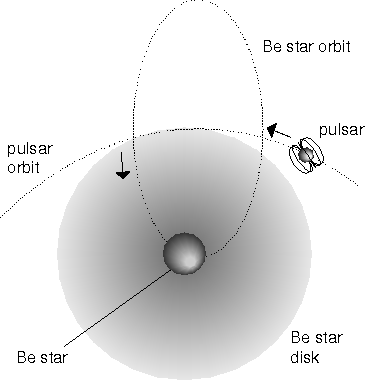 63
63
 63
63
As the pulsar PSR B125963 ploughed into the disk around its companion star, it was watched by an international team of observers, led by Simon Johnston, using most of the major Australian telescopes and two satellite-borne telescopes.
About four years ago a group based at the ATNF, of which Simon Johnston was a member, discovered an unusual binary system containing a pulsar known as PSR B1259-63 and a massive star. Pulsars are spinning neutron stars, about 1.4 times the mass of the Sun but no more than 20 kilometers across. They emit beams of radio waves that we see a series of radio pulses, in the same way as we see flashes from a rotating lighthouse beam. The pulsar B1259-63 rotates about 21 times a second. The companion of PSR B1259-63 is called a Be star: it is about ten times the mass of the Sun and is surrounded by a disk of material at its equator. The `B' indicates that it is a young, hot, massive star and the `emission' from the disk leads to the `e'.
A small fraction of known pulsars have companions which can be ordinary stars, compact stars or `planets'. However, PSR B1259-63 is one of only two with massive companion stars, and the only one with a Be star companion - one or two have planets and all the rest have compact star companions. The presence of a companion can be detected through the Doppler shift of the pulses, which makes the pulse period slightly longer when the pulsar is moving away from us and slightly shorter when it is moving toward us in its orbit.
PSR B1259-63 was discovered during a search for pulsars in the southern sky using the Parkes telescope. Subsequent observations revealed the pulsar's massive companion, with the two stars orbiting each other every three and a half years. The orbit is highly elliptical and at the point of closest approach (periastron) the pulsar ploughs through the disk surrounding the Be star. The most recent periastron occurred in January 1994. A team led by Simon Johnston have used most of the major telescopes in Australia and two satellite-based telescopes to observe the changes across the electromagnetic spectrum as the pulsar ploughs into the disk. The preliminary results of these observations are intriguing, but they have yet to be fully analysed and considered.
The sequence of events leading to the formation of a system of this kind are moderately well understood. Both stars were originally several times more massive than the Sun. The more massive of the two stars burnt its fuel faster and so evolved more rapidly than its companion. As its hydrogen fuel ran out, it swelled to form a supergiant star, hundreds of times bigger than the Sun. During this phase it lost matter from its surface, some of which was transferred onto its companion. This infalling material spun up the companion star until it was rotating so fast that it started throwing matter off at its equator. It is this material that forms the disk that the pulsar has just passed through.

Figure: A closeup of the orbits of PSR B1259-63 and its Be star companion.
Subsequently the more evolved star exploded as a supernova. A binary system may or may not be disrupted when one of the stars goes supernova. In this case it just survived, leaving a neutron star in a highly elliptical orbit around the Be star.
Due to the unique nature of the B1259-63 system, it was not clear what to expect when the pulsar ploughed through the disk. There is some evidence on how pulsars interact with their environment, including the formation of bow shocks ahead of some pulsars as they plough through interstellar clouds, and evidence that some pulsars are occulted by the wind of a companion, when simple theory suggests that the wind should be transparent to radio waves. PSR B1259-63 certainly has some surprises in store.